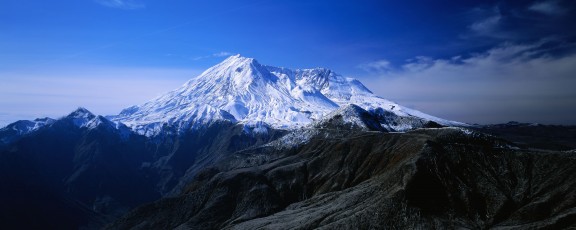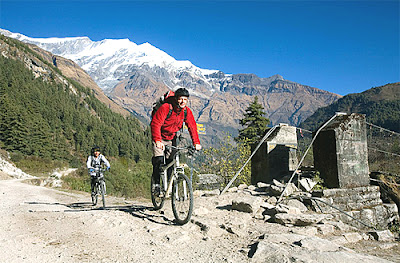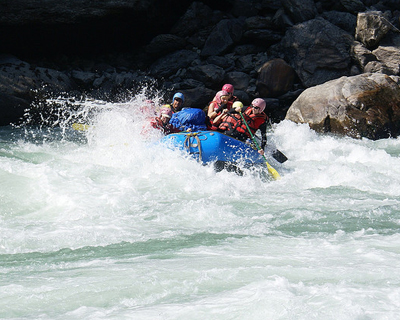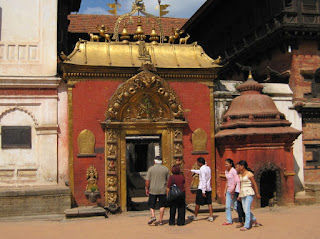Where is Nepal?
Nepal is a country of unimaginable extremes. Imagine a rectangle of 500 by 150 miles (800 by 240 kilometers), divided lengthwise into 3 strips. The northernmost strip is that the Himalayas, which means "abode of snow", and includes eight of the 10 highest mountains in the world. Nepal, a Himalayan country, is found on the slopes of the central Himalayas and represents approximately one third of its length. Nepal lies between China within the north and India within the east, south and west. it's located between latitudes twenty six ° twenty two 'and thirty ° 27' N and longitudes eighty ° forty 'and eighty eight ° 12' E. it's roughly rectangular in form and occupies a complete are of 147,181 sq. km. From one hundred forty five to 241 km with a mean average of 193 km. regarding eighty three % of its total space worries with the high mountains and rolling hills and also the remaining seventeen % of the flat lands of the Terai. The altitude varies from sixty m on top of ocean level within the Terai to eight,848 m of "Mt. Everest", that is that the world's highest peak.
The southernmost region, referred to as the Terai is an extension of the Gangetic plain in northern India, that contains the jungle with elephants, rhinos and big cat. This contrasts sharply with the inhabitants of the yaks and snow leopard but a hundred miles (160 km) north. home is everywhere, whether or not on the shoulders of highest mountains, terraced hills and stairs ascending to heaven, calm rivers or land or in forests filled with wildlife, flowers and birds. Nepal may be a year spherical destination with a distinction, be it summer, monsoon, autumn or winter. it's a splendor unequaled in all seasons betting on your mood and selection. Mother Nature has endowed this country with abundant beauty in all seasons, the delicate summer and moderate valley offers the chance to tour the temples, monuments and shrines within the leisurely manner, the monsoon provides the vies of the soothing open inexperienced valleys and occasional snow-capped peaks along the northern border. Summer or winter, at each extremes of weather, climate is surprisingly moderate and delicate.
Nepal closed to foreigners and foreign influence till 1951, is currently one among the key tourist destinations in South Asia and accessible in just about nepalvisitors.com. Nepal is that the country pious Hindu within the span of the Himalayas, that is gorgeous, quiet, the birthplace of Buddha and also the origin of Hinduism. Besides being the country of Everest is additionally widespread with various cultural values. this can be the land where civilization began and is additionally referred to as the country 'Sangrila. Nepal is such a sacred place for Hindus and Buddhists, as Mecca is to Muslims and Jerusalem for Christians and Jews. Nepal could be a country located between China and India. attributable to its geopolitical scenario, the sovereignty of Nepal has perpetually been terribly sensitive. Nepal contains a wealthy culture and, of course. Our successful foreign policy would be to take care of our culture, traditions and indigenous identities balance between China and India. In fact, Nepal could be a paradise that offers tranquility and rejuvenation of the mind. This lovely place is additionally said to the potpourri of ethnicity and has several cultural landscapes. This land of biodiversity has cultural attractions and plenty of non secular giving a soothing expertise for everybody. Nepal could be a wealthy and complicated mixture of completely different cultures and traditions, blended for thousands of years in a very single whole. For the western traveler there's a lot of that's acquainted, and plenty of surprises. Family and faith are important and is mirrored consistently in each culture. Culture provides essential data on attitudes, beliefs and behavior in numerous countries, making certain that you simply arrive at your destination conscious of basic manners, common courtesies, and sensitive problems. It provides a transparent image of the culture and society of a selected country. Nepal moves to a unique rhythm to the West. Hinduism and Buddhism, the non secular structure of Nepalese society is formally a Hindu, however here and solely here, the interaction of peoples and their non secular traditions has created an expensive fusion of Hindu and Buddhist religions. it's common for Hindus and Buddhists worship within the sanctuary itself, of the many gods and saints are cross-over, typically known by a unique name, however keeping a similar attributes. the initial inhabitants of the valley were animists, a practice that survives within the multitude of spirits, demons, native deities and worship the stones that are compliant to this point. Hindu and Buddhist traditions adapting pre-existing animist practices and others. In fact, in medieval times, when the observe of each religions "adopted mystical traditions, tantric, that were virtually indistinguishable from one another. History of Nepal Nepal and religions could be a mixture of wealthy and complicated cultures and traditions, blended for thousands of years in a very single whole. For the western traveler there's a lot of that's acquainted, and plenty of surprises. Family and faith are important and is mirrored consistently in each culture. Nepal moves to a unique rhythm to the West. The notes here serve solely to entice you to go to this glorious place.
ECONOMY:
Nepal is a developing country with an agricultural economy. In recent year, the country's efforts to expand into producing and alternative technological sectors have achieved a lot of progress. Agriculture is that the main activity followed by producing ECOMIC, trade and tourism, the most sources of foreign exchange earnings are exports of products, services, tourism and Gurkha remittances. The annual Gross Domestic Products (G.D.P.) is approximately USD 5 billions.
AGRICULTURE:
Eight out of ten Nepalese are engaged in agriculture and is answerable for quite four-hundredth of GDP. Rolling fields and terraces will be seen clear across the plains of Terai and also the hills of Nepal. Even within the highly urbanized Kathmandu Valley, massive tracts of land outside the town areas are dedicated to rice is that the staple food in Nepal and around 3 million are created annually. alternative vital crops are maize, wheat, millet and barley. additionally to cereals, money crops like sugarcane, oil seeds, snuff, jute and tea are grown in massive quantities. additional recently, cardamom is turning into one in every of the foremost fashionable crops within the japanese a part of the country.
MANUFACTURING:
Manufacturing continues to be within the developmental stage and represents but 100% of GDP. Major industries are woolen carpets, garments, textiles, leather product, paper and cement. different product manufactured in Nepal are steel utensils, cigarettes, beverages and sugar. Modem There are several giant factories, however most are tiny family operations or scale. Most of the business of Nepal is predicated within the Kathmandu Valley and a series of tiny cities within the southern plains of Terai.
TRADE:
Trade has been a serious occupation in Nepal since early times. Being located at the crossroad of ancient trans-Himalayan trade route, trading is second nature to the Nepali(Nepalese) folks. Foreign trade is characterised mainly by import of manufactured merchandise and export of agricultural commodities. Nepal imports manufactured merchandise and petroleum product price concerning U.S. $ one billion a year. The export price is approximately U.S. $ 320 million. Wool carpets are Nepal's largest export, earning the country U.S. $ one hundred thirty five million per year. Exports of attire represent over U.S. $ seventy four million to bring U.S. crafts $ one million. different necessary export are pulses, hides and skins, jute and medicinal herbs.
TOURISM:
In 1996, a complete of 390,000 tourists visited Nepal, creating tourism one in every of the most important industries within the Kingdom. This sector has been expanding rapidly since its inception within the Fifties, because of Nepal's natural beauty, made cultural heritage and therefore the diversity of sight-seeing and journey opportunities out there. At just the once, tourism used to be the largest foreign currency earner for the country. Nepal earned over US $ 150 million from tourism in 1995.
Nepal is a country of unimaginable extremes. Imagine a rectangle of 500 by 150 miles (800 by 240 kilometers), divided lengthwise into 3 strips. The northernmost strip is that the Himalayas, which means "abode of snow", and includes eight of the 10 highest mountains in the world. Nepal, a Himalayan country, is found on the slopes of the central Himalayas and represents approximately one third of its length. Nepal lies between China within the north and India within the east, south and west. it's located between latitudes twenty six ° twenty two 'and thirty ° 27' N and longitudes eighty ° forty 'and eighty eight ° 12' E. it's roughly rectangular in form and occupies a complete are of 147,181 sq. km. From one hundred forty five to 241 km with a mean average of 193 km. regarding eighty three % of its total space worries with the high mountains and rolling hills and also the remaining seventeen % of the flat lands of the Terai. The altitude varies from sixty m on top of ocean level within the Terai to eight,848 m of "Mt. Everest", that is that the world's highest peak.
The southernmost region, referred to as the Terai is an extension of the Gangetic plain in northern India, that contains the jungle with elephants, rhinos and big cat. This contrasts sharply with the inhabitants of the yaks and snow leopard but a hundred miles (160 km) north. home is everywhere, whether or not on the shoulders of highest mountains, terraced hills and stairs ascending to heaven, calm rivers or land or in forests filled with wildlife, flowers and birds. Nepal may be a year spherical destination with a distinction, be it summer, monsoon, autumn or winter. it's a splendor unequaled in all seasons betting on your mood and selection. Mother Nature has endowed this country with abundant beauty in all seasons, the delicate summer and moderate valley offers the chance to tour the temples, monuments and shrines within the leisurely manner, the monsoon provides the vies of the soothing open inexperienced valleys and occasional snow-capped peaks along the northern border. Summer or winter, at each extremes of weather, climate is surprisingly moderate and delicate.
Nepal closed to foreigners and foreign influence till 1951, is currently one among the key tourist destinations in South Asia and accessible in just about nepalvisitors.com. Nepal is that the country pious Hindu within the span of the Himalayas, that is gorgeous, quiet, the birthplace of Buddha and also the origin of Hinduism. Besides being the country of Everest is additionally widespread with various cultural values. this can be the land where civilization began and is additionally referred to as the country 'Sangrila. Nepal is such a sacred place for Hindus and Buddhists, as Mecca is to Muslims and Jerusalem for Christians and Jews. Nepal could be a country located between China and India. attributable to its geopolitical scenario, the sovereignty of Nepal has perpetually been terribly sensitive. Nepal contains a wealthy culture and, of course. Our successful foreign policy would be to take care of our culture, traditions and indigenous identities balance between China and India. In fact, Nepal could be a paradise that offers tranquility and rejuvenation of the mind. This lovely place is additionally said to the potpourri of ethnicity and has several cultural landscapes. This land of biodiversity has cultural attractions and plenty of non secular giving a soothing expertise for everybody. Nepal could be a wealthy and complicated mixture of completely different cultures and traditions, blended for thousands of years in a very single whole. For the western traveler there's a lot of that's acquainted, and plenty of surprises. Family and faith are important and is mirrored consistently in each culture. Culture provides essential data on attitudes, beliefs and behavior in numerous countries, making certain that you simply arrive at your destination conscious of basic manners, common courtesies, and sensitive problems. It provides a transparent image of the culture and society of a selected country. Nepal moves to a unique rhythm to the West. Hinduism and Buddhism, the non secular structure of Nepalese society is formally a Hindu, however here and solely here, the interaction of peoples and their non secular traditions has created an expensive fusion of Hindu and Buddhist religions. it's common for Hindus and Buddhists worship within the sanctuary itself, of the many gods and saints are cross-over, typically known by a unique name, however keeping a similar attributes. the initial inhabitants of the valley were animists, a practice that survives within the multitude of spirits, demons, native deities and worship the stones that are compliant to this point. Hindu and Buddhist traditions adapting pre-existing animist practices and others. In fact, in medieval times, when the observe of each religions "adopted mystical traditions, tantric, that were virtually indistinguishable from one another. History of Nepal Nepal and religions could be a mixture of wealthy and complicated cultures and traditions, blended for thousands of years in a very single whole. For the western traveler there's a lot of that's acquainted, and plenty of surprises. Family and faith are important and is mirrored consistently in each culture. Nepal moves to a unique rhythm to the West. The notes here serve solely to entice you to go to this glorious place.
ECONOMY:
Nepal is a developing country with an agricultural economy. In recent year, the country's efforts to expand into producing and alternative technological sectors have achieved a lot of progress. Agriculture is that the main activity followed by producing ECOMIC, trade and tourism, the most sources of foreign exchange earnings are exports of products, services, tourism and Gurkha remittances. The annual Gross Domestic Products (G.D.P.) is approximately USD 5 billions.
AGRICULTURE:
Eight out of ten Nepalese are engaged in agriculture and is answerable for quite four-hundredth of GDP. Rolling fields and terraces will be seen clear across the plains of Terai and also the hills of Nepal. Even within the highly urbanized Kathmandu Valley, massive tracts of land outside the town areas are dedicated to rice is that the staple food in Nepal and around 3 million are created annually. alternative vital crops are maize, wheat, millet and barley. additionally to cereals, money crops like sugarcane, oil seeds, snuff, jute and tea are grown in massive quantities. additional recently, cardamom is turning into one in every of the foremost fashionable crops within the japanese a part of the country.
MANUFACTURING:
Manufacturing continues to be within the developmental stage and represents but 100% of GDP. Major industries are woolen carpets, garments, textiles, leather product, paper and cement. different product manufactured in Nepal are steel utensils, cigarettes, beverages and sugar. Modem There are several giant factories, however most are tiny family operations or scale. Most of the business of Nepal is predicated within the Kathmandu Valley and a series of tiny cities within the southern plains of Terai.
TRADE:
Trade has been a serious occupation in Nepal since early times. Being located at the crossroad of ancient trans-Himalayan trade route, trading is second nature to the Nepali(Nepalese) folks. Foreign trade is characterised mainly by import of manufactured merchandise and export of agricultural commodities. Nepal imports manufactured merchandise and petroleum product price concerning U.S. $ one billion a year. The export price is approximately U.S. $ 320 million. Wool carpets are Nepal's largest export, earning the country U.S. $ one hundred thirty five million per year. Exports of attire represent over U.S. $ seventy four million to bring U.S. crafts $ one million. different necessary export are pulses, hides and skins, jute and medicinal herbs.
TOURISM:
In 1996, a complete of 390,000 tourists visited Nepal, creating tourism one in every of the most important industries within the Kingdom. This sector has been expanding rapidly since its inception within the Fifties, because of Nepal's natural beauty, made cultural heritage and therefore the diversity of sight-seeing and journey opportunities out there. At just the once, tourism used to be the largest foreign currency earner for the country. Nepal earned over US $ 150 million from tourism in 1995.





























